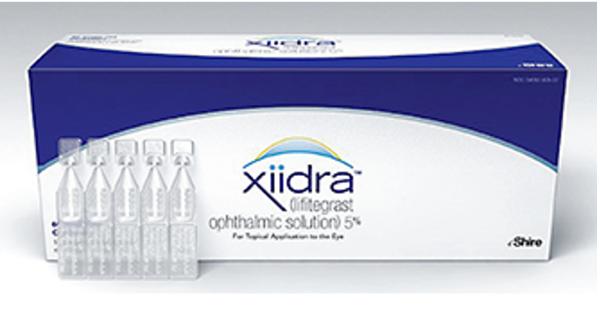Lifitegrast (EENT) (Monograph)
Brand name: Xiidra
Drug class: Anti-inflammatory Agents
Introduction
Anti-inflammatory agent; integrin lymphocyte function-associated antigen-1 (LFA-1) inhibitor.
Uses for Lifitegrast (EENT)
Dry Eye Disease
Management of dry eye disease (also known as keratoconjunctivitis sicca).
Lifitegrast (EENT) Dosage and Administration
Administration
Ophthalmic Administration
Apply topically to the eye as an ophthalmic solution. For topical ophthalmic use only.
Remove contact lenses prior to administration; may reinsert lenses 15 minutes after administration.
Avoid eye injury or contamination of the solution container. Do not touch tip of single-use container to the eye or any other surface.
Sufficient amount of solution in each single-use container for administration of 1 dose into each eye. Preservative-free solution is for single use only; discard any unused portion immediately after administration.
Dosage
Adults
Dry Eye Disease
Ophthalmic
1 drop of a 5% solution in each eye twice daily, approximately 12 hours apart.
Special Populations
No special population recommendations at this time.
Cautions for Lifitegrast (EENT)
Contraindications
-
Manufacturer states none known.
Warnings/Precautions
Specific Populations
Pregnancy
No data available regarding use in pregnant women.
No evidence of teratogenicity in pregnant rats. Increased incidence of omphalocele in pregnant rabbits.
Lactation
Not known whether distributed into milk. No data available regarding effects on breast-fed infant or milk production.
Consider developmental and health benefits of breast-feeding along with mother's clinical need for the drug and any potential adverse effects of the drug on the infant.
Pediatric Use
Safety and efficacy not established in pediatric patients <17 years of age.
Geriatric Use
No overall differences in safety or efficacy relative to younger adults.
Common Adverse Effects
Ocular effects: Instillation site irritation, reduced visual acuity, blurred vision, conjunctival hyperemia, irritation, increased lacrimation, discharge, discomfort, pruritus.
Nonocular effects: Dysgeusia, headache, sinusitis.
Drug Interactions
No formal drug interaction studies to date.
Lifitegrast (EENT) Pharmacokinetics
Absorption
Bioavailability
Rapidly absorbed into ocular tissues following topical application; peak tear concentrations occur at 0.3 hours after twice-daily administration.
Does not produce clinically important systemic exposure of lifitegrast or systemic inhibition of lymphocyte function.
Following topical administration of lifitegrast 5% solution to the eye twice daily for 180 and/or 360 days, 19% of patients had lifitegrast trough concentrations above the lower limit of quantitation (0.5 ng/mL).
Distribution
Extent
Not known whether distributed into milk after topical application to the eye.
Elimination
Cleared from plasma in 1–4 hours after topical application to the eye.
Stability
Storage
Ophthalmic
Solution
20–25°C.
Actions
-
LFA-1 antagonist.
-
Interaction between LFA-1 and intercellular adhesion molecule-1 (ICAM-1) contributes to T-cell activation and migration to target tissues and secretion of inflammatory cytokines. Binding of lifitegrast to LFA-1 blocks interaction between LFA-1 and ICAM-1, thereby inhibiting T-cell adhesion to ICAM-1 and secretion of cytokines.
-
Exact mechanism of action in dry eye disease not known, but ICAM-1 may be overexpressed in corneal and conjunctival tissues in dry eye disease and T-cell-mediated inflammation may play a role.
Advice to Patients
-
Importance of learning and adhering to proper administration techniques to avoid eye injury or contamination of the ophthalmic solution.
-
Importance of storing single-use containers in original foil pouch until ready to use.
-
Importance of administering ophthalmic solution immediately after opening the single-use container and discarding any unused portion immediately after administration.
-
If contact lenses are worn, importance of removing lenses prior to administration and delaying reinsertion of lenses for 15 minutes after administration.
-
Importance of women informing clinicians if they are or plan to become pregnant or plan to breast-feed.
-
Importance of informing clinicians of existing or contemplated concomitant therapy, including prescription and OTC drugs, as well as any concomitant illnesses.
-
Importance of informing patients of other important precautionary information. (See Cautions.)
Additional Information
The American Society of Health-System Pharmacists, Inc. represents that the information provided in the accompanying monograph was formulated with a reasonable standard of care, and in conformity with professional standards in the field. Readers are advised that decisions regarding use of drugs are complex medical decisions requiring the independent, informed decision of an appropriate health care professional, and that the information contained in the monograph is provided for informational purposes only. The manufacturer’s labeling should be consulted for more detailed information. The American Society of Health-System Pharmacists, Inc. does not endorse or recommend the use of any drug. The information contained in the monograph is not a substitute for medical care.
Preparations
Excipients in commercially available drug preparations may have clinically important effects in some individuals; consult specific product labeling for details.
Please refer to the ASHP Drug Shortages Resource Center for information on shortages of one or more of these preparations.
|
Routes |
Dosage Forms |
Strengths |
Brand Names |
Manufacturer |
|---|---|---|---|---|
|
Ophthalmic |
Solution |
5% |
Xiidra |
Shire |
AHFS DI Essentials™. © Copyright 2025, Selected Revisions June 10, 2024. American Society of Health-System Pharmacists, Inc., 4500 East-West Highway, Suite 900, Bethesda, Maryland 20814.
Reload page with references included
Related/similar drugs
Frequently asked questions
- What are the best eye drops for dry eyes?
- How much is Xiidra without insurance?
- How is Xiidra packaged at the pharmacy?
- How does Xiidra differ from OTC dry eye treatments?
- Can I use other eye drops with Xiidra?
- How long does it take for Xiidra to work?
More about lifitegrast ophthalmic
- Compare alternatives
- Reviews (462)
- Side effects
- Dosage information
- During pregnancy
- Drug class: ophthalmic anti-inflammatory agents
- Breastfeeding
- En español

